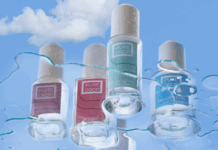At this year's congress of the International Federation of Societies of Cosmetic Chemists (IFSCC), BASF scientists will be presenting the latest discoveries and research methods for the development of effective cosmetic products. Among the most noteworthy research results is the discovery of the age-related decline in skin bacteria, and the development of a cosmetic ingredient containing living micro-organisms to fill this gap. Other research projects include a new "neuroskin-on-chip" technology used for the first time and developed by Netri to create a 3D internalized skin model, and a joint study with Stanford University on emollients that can reduce skin dryness and promote skin well-being. BASF scientists and experts will discuss the effects and opportunities in poster and panel presentations.
A new method reveals the particularities of sensitive skin
Although the microbiome is known to play an important role in skin health, its influence on skin sensitivity has until now received little attention. In a recent study, BASF scientists examined the composition of the skin microbiota of people with sensitive skin compared to people with non-sensitive skin. The analysis revealed changes in the presence and abundance of common and specific bacterial strains. For the first time, a droplet-based microfluidic technolgy (DBMT) developed by Biomillenia was used to isolate these bacterial strains in culture. The resulting microbial library can be used to identify and test active substances with the best potential for restoring the microbiota balance of sensitive skin.
Neuroskin-on-chip" technology mimics innervated skin
For healthy skin, a functional supply network of nerve cells is an essential factor. To develop and test neurocosmetics that help improve interactions between the skin and the nervous system, and thus reduce signs of aging or skin stress, specific skin models are required. In collaboration with NETRI, a French start-up specializing in the rapid prototyping of "organs on a chip", BASF has succeeded in developing an innervated epidermis on a chip for the first time. Compared with existing models of innervated epidermis or conventional cocultured skin, the new "neuroskin-on-chip" technology better mimics the real innervation physiology of the skin. It thus facilitates and enhances the study of highly effective neurocosmetic active substances.
A selection of emollients promotes skin hydration
How people assess the effectiveness of skincare products is highly dependent on skin hydration and cutaneous biomechanics. To optimize performance, it is therefore important to better understand the effects of biomechanical stresses that occur during dehydration of the stratum corneum. To investigate the influence of cosmetic ingredients at different levels of air and therefore skin humidity, a research team from BASF and Professor Reinhold Dauskardt's laboratory at Stanford University analyzed skin care formulations containing different emollients with very different properties and molecular structures. The results indicate that by carefully selecting emollients and other ingredients, it is possible to reduce biomechanical stress on the skin and promote its well-being.
Anti-aging probiotic ingredient containing live bacteria
Skin aging remains one of the most important areas in cosmetics. To better understand the link between aging and changes in the skin microbiome, BASF researchers conducted a study with young and elderly subjects. It revealed considerable differences in the population of Lactobacillus strains. In particular, L. crispatus was identified as a "youth bacterium": it was present in abundance in young skin, but was not detectable in the folds of older participants. These results formed the basis for the development of a probiotic for skincare products designed to promote healthy skin aging. The research team succeeded in developing a product that guarantees the survival of the bacteria it contains when used in appropriate cosmetic formulations. This makes the ingredient the first cosmetic active based on living, skin-clean bacteria. Its effectiveness in reducing the visible signs of skin ageing has been demonstrated in vitro and in vivo against a placebo.
Strategy to reduce age-related changes in scalp and hair using plant extracts
With age, the structure of the scalp and its ability to regenerate change. As a result, hair loss can occur, which can affect self-confidence and well-being. BASF scientists have developed a comprehensive anti-aging approach for the scalp and hair follicles, based on a tempering strategy and pursuing three main objectives: to reduce scalp sensitivity by protecting the skin barrier, to balance the microbiota and to reduce excessive immune response. To this end, plant extracts were selected for their TRPV1 antagonistic properties. The best extract was then studied for its effects on the above-mentioned parameters. This approach led to the identification of a plant extract capable of counteracting age-related changes in the scalp and hair.
Interactive matrix for anti-pollution skin care products
Pollutants differ in both their nature and their effect on the skin. Cosmetic products must therefore be formulated accordingly, and their effectiveness must be proven. The Anti-Pollution Working Group of the German Society for Scientific and Applied Cosmetics (DGK) has developed a publicly accessible interactive matrix containing information on air pollutants, some of their effects on the skin, cosmetic ingredients and application methods, as well as relevant methods for assessing efficacy. The matrix does not claim to be exhaustive, but it does provide a better understanding of the factors involved. It also shows how the challenges of proving a product's promise can be overcome when developing relevant skin care products.








